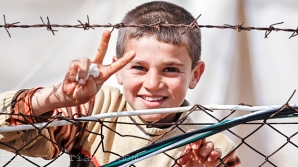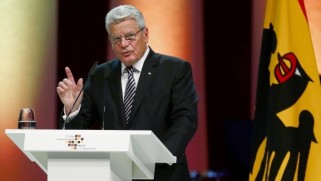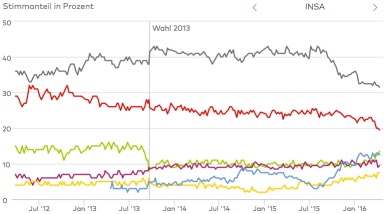In a post from September 2015 I had written about how Germany plans to get 250,000 refugee children into school. Much has happened in the last six months and I’d like to give you a short update:

A Syrian refugee flashes a victory sign at Reyhanli refugee camp in Hatay province on the Turkish-Syrian border March 31, 2012. REUTERS/Osman Orsal
The German education system welcomed 325,000 refugee children in the years 2014 and 2015 (Source). With about 11 million students (Source), the additional 325,000 children make up about 3% of the overall student body. The Ministers of Education (Kultusministerkonferenz) has already recruited 12,000 new teachers over the last 2 years, but that is hardly sufficient. At the moment, Germany is looking for 20,000 additional teachers (Source). However, the President of the Deutsche Lehrerverband Josef Kraus stated that 400,000 to 500,000 children can be expected in the long run, which would imply 50,000 additional teachers would be needed. Retired teachers have received letters in their mail from the state asking them to consider returning to school (Source). The additional costs are estimated at €2.3 billion a year (Source).
 The German President Joachim Gauck already stated last year that the integration of migrants into German society is a bigger challenge than the German reunification process that began in 1990 and continues to this day. Paraphrasing Gauck, while German reunification was about merging two parts that belonged together, today’s integration is about merging two parts that didn’t belong together before (Source). Especially the cultural differences will pose a major challenge for both sides – Germans as well as Syrians/Iraqis/Afghans/…
The German President Joachim Gauck already stated last year that the integration of migrants into German society is a bigger challenge than the German reunification process that began in 1990 and continues to this day. Paraphrasing Gauck, while German reunification was about merging two parts that belonged together, today’s integration is about merging two parts that didn’t belong together before (Source). Especially the cultural differences will pose a major challenge for both sides – Germans as well as Syrians/Iraqis/Afghans/…
The numbers are not necessarily the biggest challenge. The UK for example is expecting 615,000 additional students until 2020 (Source), which is significantly more than what Germany expects. However, the additional 5 years of planning time that the UK has to its disposal is only one aspect that makes this comparison rather problematic. Nearly all of the children arriving in Germany do not speak German, while most of the additional students in the UK are expected to have some or even advanced English skills. Since January 2016, the German education system has already been offering 8,200 introductory classes to 194,000 refugee children across the (Source). The idea is to teach children basic German skills before transitioning them into the regular classroom.
While the UK can largely focus on simply teaching their newcomers, the German education system will have to do much more. The Social Pediatrics Department of the Technical University Munich estimates that 22.3% of refugee children suffer from post-traumatic stress disorder (PTSD) (Source). With an estimated 325,000 refugees in school, this would imply 36,000 cases of PTSD. Michael Deckert who manages daycare centers in Würzburg recalls: “All kids are happily playing in the garden when suddenly a rescue helicopter flies over the compound towards the university hospital. The German kids look up, laugh and wave – the Syrian kids hide and run screaming into the house filled with fear” (Source). There is a dire need for social workers and special training for teachers to help these children (Source).
 Does the German population support the integration of so many newcomers? Looking at a popularity poll for the major German political parties shows that the CDU (grey line) led by Chancellor Angela Merkel lost considerably over the last year. In contrast, the AfD (blue line), a right-wing populist party, has gained massively. In February 2016, 47% of Germans thought that Merkel was doing a rather good job, while 50% were dissatisfied with it (Source). That is still a considerable amount of support given the recent terrorist attacks in Paris and Brussels, which could have easily led to a more widespread anti-refugee populist right-wing movement. Around September 2015 Germany welcomed on some days more than 10,000 refugees per day. That figure has dropped to 200 (Source) due to fences along the Balkan countries as well as an agreement with Turkey that obliges the country to take back any refugee who reaches EU soil without an entry permit. This makes the situation less acute and is expected to weaken populist right-wing groups such as the AfD.
Does the German population support the integration of so many newcomers? Looking at a popularity poll for the major German political parties shows that the CDU (grey line) led by Chancellor Angela Merkel lost considerably over the last year. In contrast, the AfD (blue line), a right-wing populist party, has gained massively. In February 2016, 47% of Germans thought that Merkel was doing a rather good job, while 50% were dissatisfied with it (Source). That is still a considerable amount of support given the recent terrorist attacks in Paris and Brussels, which could have easily led to a more widespread anti-refugee populist right-wing movement. Around September 2015 Germany welcomed on some days more than 10,000 refugees per day. That figure has dropped to 200 (Source) due to fences along the Balkan countries as well as an agreement with Turkey that obliges the country to take back any refugee who reaches EU soil without an entry permit. This makes the situation less acute and is expected to weaken populist right-wing groups such as the AfD.
Although the outcome of the refugee crisis is as unclear today as it was two years ago, the country has committed itself already on all levels (political, economical, social) to the challenge. The question is not whether refugees should be admitted, but rather how they can be integrated successfully. Although nationalist right-wing movements are still strong, there is still a solid base within society, which supports the current course of action. I want to leave you with a video that the German comedian Jan Böhmermann made as a protest against right-wing groups.
